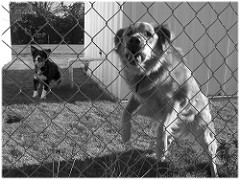Labrador Retrievers, Golden Retrievers, Chesapeake Bay Retrievers, mixed retriever breeds as well as all water dogs can have more enriched lives by learning training techniques used by duck hunters.
Once the owner of a retriever has learned the skills to teach his dog all he can be in the field a new world opens up. Training your retriever can become a highlight of family activities and at the same time give the retriever all the exercise he needs.
Too often retriever owners make the mistake of assuming only hunting dogs need to be taught marks and lines. But it is these exercises that keep the dog exercised and at the same time fulfills the basic need to retrieve. Not just throwing a toy a few feet but rather retrieves from a distance. This is referred to as a mark. The dog watches the dummy as it is thrown and then marks the location of the fall. Training dummies are used for this activity and can found at dog supply stores.
A single mark is the best exercise to teach the dog to mark. You will need a helper to throw the dummy. It is best to start with one person helping. Having two or more helpers in the field can cause the dog to gaze back and forth and disrupt his marking ability.
Double marks can motivate the dog to return quickly to retrieve another mark. Have your helper throw a dummy in one direction (approximately 50 feet to begin) and another helper throw a closer mark. Having your dog retrieve the last mark thrown is the usual order of pick up. Place the helpers so that there is no chance of going to the wrong mark. The more distant mark is often referred to as the memory mark. The dog will learn to judge distance if you vary the location of the helpers at each new marking lesson.
You will have a very enjoyable training session as long as each participant knows his job. Here are the steps to keep in mind. The handler places the helper in the field and decides where the starting line should be. He then heels his dog to the line holding him by a rope attached to the collar. He signals the helper with his free arm to throw. The dog must follow the flight of the dummy until it lands and only when the dog is intently fixed on it does the handler send the dog. The helper should remain silent facing the mark as the dog makes the retrieve.
When you are first beginning, find a park-like area with mowed grass and always try to use white dummies since dogs do not see red. Initially, do short marks about 50 feet or less. After a few weeks the training exercises can include water work. So if you are at a pond, lake, or river you can have lots of fun with marking retrieves across the water giving the dog a chance to do what he was bred to do. Once your retriever has successfully retrieved a mark it can be repeated without the helper. This is referred to as giving the dog a line.
The requirement to accomplish the above exercises is basic obedience. This must include the ability to return to the hander to deliver the dummy. Fun short marks can be introduced as early as four months old. Most dogs need a number of months to prepare for marking lessons.

 City Slickers: 5 Tips for Urban Living with Cats & Dogs
City Slickers: 5 Tips for Urban Living with C
City Slickers: 5 Tips for Urban Living with Cats & Dogs
City Slickers: 5 Tips for Urban Living with C
 How Much Exercise Does My Dog Need?
How Much Exercise Does My Dog Need?
How Much Exercise Does My Dog Need?
How Much Exercise Does My Dog Need?
 Doggie Play Dates: Are They for Your Dog?
Doggie Play Dates: Are They for Your Dog?
Doggie Play Dates: Are They for Your Dog?
Doggie Play Dates: Are They for Your Dog?
 Stop Dog Barking: The Real Approach To Train Your New Family Dog.
Part of training your dog to stop dog barking is learning t
Stop Dog Barking: The Real Approach To Train Your New Family Dog.
Part of training your dog to stop dog barking is learning t
 Does Your Dog Need More Exercise?
Does Your Dog Need More Exercise?
Does Your Dog Need More Exercise?
Does Your Dog Need More Exercise?